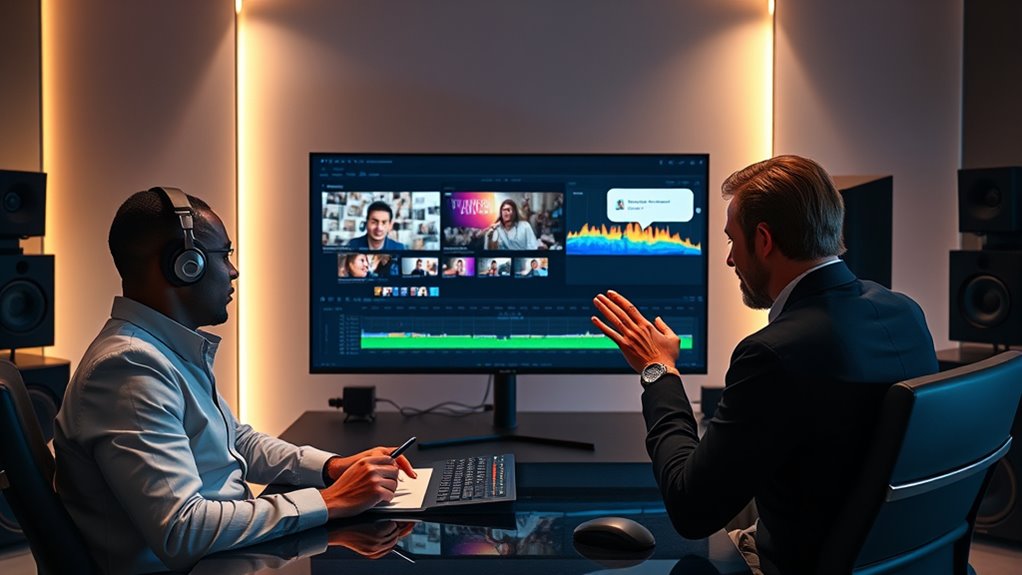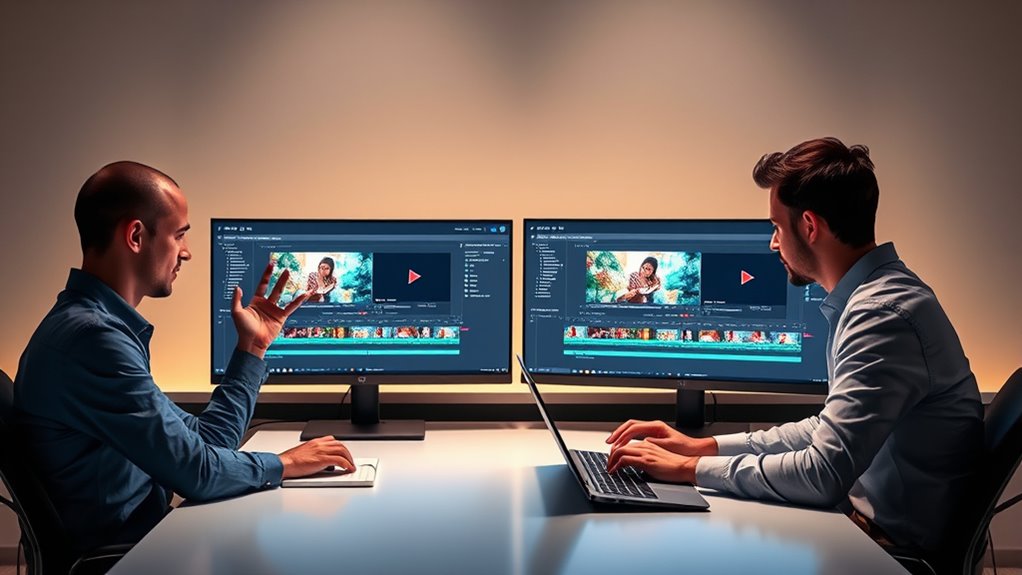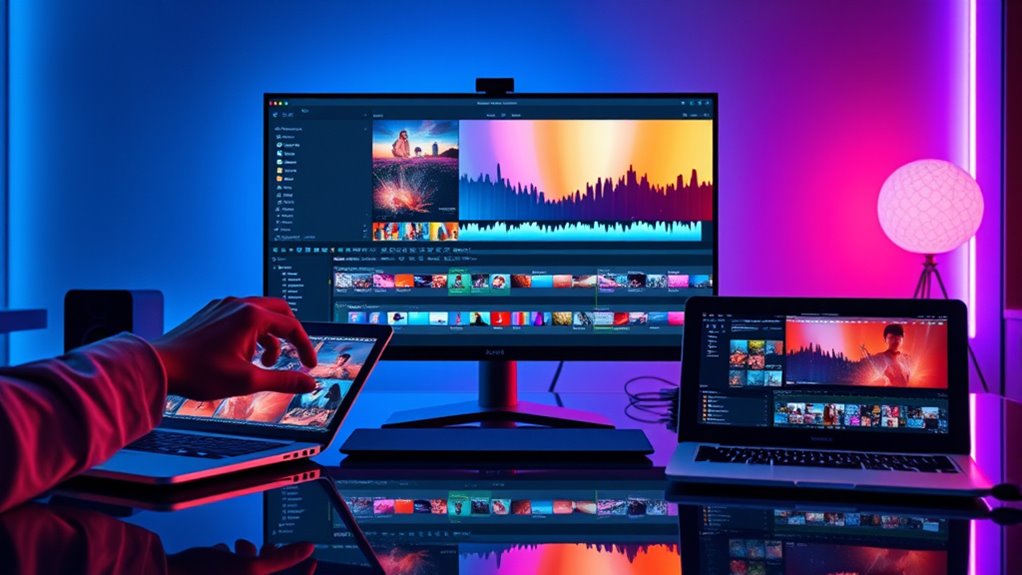Real-time collaboration in browser-based video editors lets you co-create and edit videos seamlessly across devices with teams anywhere. Using WebSocket and cloud tech, these platforms support instant updates, shared access, and conflict resolution that keep everyone on the same page. You can work on projects simultaneously, enjoy streamlined workflows, and maintain data security. If you’d like to discover how these features come together to enhance your editing experience, there’s more to explore ahead.
Key Takeaways
- WebSocket protocols enable low-latency, persistent connections for real-time editing among multiple users.
- Cloud synchronization ensures project consistency and automatic version control during collaborative workflows.
- Conflict resolution techniques like OT and CRDTs manage simultaneous edits seamlessly.
- Secure, encrypted channels protect data privacy and facilitate safe real-time collaboration.
- User access controls and intuitive interfaces enhance teamwork and prevent unauthorized modifications.
The Rise of Browser-Based Video Editing Platforms

The popularity of browser-based video editing platforms has surged in recent years, driven by advances in web technologies and increased demand for accessible, collaborative tools. These platforms enable you to work seamlessly across devices, fostering remote teamwork without the need for heavy software installations. With cross-platform compatibility, you can edit videos on Windows, Mac, Linux, or even tablets, making collaboration flexible and efficient. As more creators seek real-time input and streamlined workflows, browser-based editors have become essential. They eliminate compatibility issues and bring teams together regardless of location or device. This shift not only simplifies access but also enhances productivity, making professional-quality video editing more inclusive and adaptable to today’s remote work environment. Regularly assessing and organizing your workflow can further improve efficiency and collaboration. Embracing web-based editing tools also allows for easier updates and integration of new features, keeping platforms current with technological innovations. Incorporating cloud storage ensures that project files are accessible and backed up securely, further supporting remote collaboration. Additionally, software updates are delivered automatically, reducing technical barriers and keeping platforms secure. As web technologies continue to evolve, they enable more advanced features like real-time collaboration, which further enhances the user experience and overall productivity.
Key Technologies Powering Real-Time Collaboration

To enable seamless real-time collaboration, your platform relies on key technologies like WebSocket protocols for instant data exchange. Cloud storage integration guarantees all users access the latest project updates without delays, while conflict resolution techniques keep edits synchronized smoothly. Additionally, incorporating regional legal resources can help tailor features that address specific user needs based on their location. Understanding these technologies helps you build a more efficient and reliable collaborative editing experience. Incorporating cloud synchronization concepts can also inspire innovative features that promote healthier work habits and better user engagement, especially when considering the importance of mental wellbeing indexes in maintaining long-term productivity. Moreover, leveraging AI security measures ensures that collaborative platforms remain protected against cyber threats, safeguarding sensitive content during real-time editing.
WebSocket Protocols
WebSocket protocols serve as the backbone of real-time collaboration in browser-based video editors by enabling persistent, low-latency communication between your browser and the server. They establish encrypted channels, guaranteeing your data remains secure during transfer. The connection begins with a handshake, where your browser and server agree on protocols and security settings. Once established, the WebSocket stays open, allowing continuous data exchange without repeated reconnections. This efficiency is vital for synchronized editing. The table below highlights key aspects:
| Aspect | Description | Importance |
|---|---|---|
| Connection Handshake | Initial secure setup between client and server | Ensures secure, reliable link |
| Encrypted Channels | Data transmitted securely over WebSocket | Protects sensitive information |
| Persistent Connection | Maintains ongoing communication | Reduces latency and delays |
These elements work together to power seamless, real-time collaboration. Additionally, low-latency communication ensures that edits are reflected instantly across all users, maintaining a smooth editing experience. Incorporating secure data transfer practices further enhances the reliability and safety of the collaborative environment. Understanding how efficient protocols facilitate continuous interaction is essential for developing robust browser-based editing tools. Moreover, the use of Personality Test principles can help in designing user interfaces that foster better collaboration and understanding among users.
Cloud Storage Integration
Cloud storage integration plays a pivotal role in enabling real-time collaboration within browser-based video editors by providing seamless access to project files and media assets across devices. It guarantees that everyone involved can work on the latest versions without manual transfers or synchronization issues. By connecting your editor to cloud storage, you benefit from automatic version control, which tracks changes and allows you to revert to previous states if needed. This integration reduces the risk of conflicts and missing assets, streamlining the editing process. Additionally, cloud storage simplifies sharing and collaboration, enabling multiple users to access and update files simultaneously. Incorporating easy-to-clean materials can also help maintain the overall system, reducing downtime due to maintenance. Moreover, implementing reliable synchronization mechanisms ensures that updates are consistently reflected across all users’ devices, preventing discrepancies. Employing robust security protocols further safeguards sensitive project data and maintains user privacy. Utilizing secure data transfer protocols further enhances the safety and integrity of your collaborative editing environment. Using automated conflict resolution techniques can also help prevent editing overlaps and ensure a smoother workflow. Overall, integrating cloud storage enhances efficiency, ensures data consistency, and supports smooth, real-time teamwork in browser-based video editing environments.
Conflict Resolution Techniques
Effective conflict resolution techniques are essential for maintaining seamless real-time collaboration in browser-based video editors. When multiple users edit simultaneously, version conflicts can occur, risking data loss or inconsistent project states. To handle this, systems often track user identity, so each change is attributed correctly. Conflict resolution algorithms detect overlapping edits and prioritize them based on timestamps or user permissions. Techniques like Operational Transformation (OT) and Conflict-Free Replicated Data Types (CRDTs) enable real-time synchronization while resolving conflicts automatically. These methods ensure that updates from different users merge smoothly, minimizing disruptions. By accurately identifying user identity and managing version conflicts, these techniques keep collaboration fluid, preventing confusion and ensuring everyone stays on the same page throughout the editing process.
Overcoming Challenges in Synchronous Video Editing

Achieving seamless synchronous video editing in a browser environment presents several significant challenges. One major hurdle is designing a user interface that remains intuitive despite the complexity of real-time collaboration. You need to balance functionality with simplicity so users can focus on editing without confusion. Additionally, managing user access control is critical; you must guarantee that only authorized users can make changes, preventing accidental edits or conflicts. Synchronizing media assets and edits across multiple users in real time demands efficient data handling and low latency. Network variability can cause delays, so optimizing for a stable connection is essential. Furthermore, implementing on-device AI capabilities can assist in streamlining editing tasks and improving performance. Incorporating preppy dog names into your application’s branding or feature set could appeal to a demographic that appreciates sophisticated aesthetics, making the tool more engaging. By addressing these hurdles, you enable smooth collaboration, making your browser-based video editor both powerful and user-friendly.
Features That Enable Seamless Teamwork

You need tools that let your team edit videos simultaneously without missing a beat. Real-time editing capabilities make certain everyone’s changes appear instantly, keeping the workflow smooth. Cloud-based synchronization keeps all team members on the same page, no matter where they are. Additionally, store hours information ensures that team members can coordinate their in-person meetings or support during service times. Incorporating collaborative editing features can further enhance team productivity by allowing multiple users to work on the same project seamlessly.
Real-Time Editing Capabilities
Real-time editing capabilities are the cornerstone of seamless teamwork in browser-based video editors. They allow you and your team to work simultaneously on the same project without delays. With robust version control, you can track changes and revert to previous versions if needed, ensuring your work stays organized. User permissions play a crucial role, giving you control over who can edit, comment, or view specific parts of the project, enhancing security and accountability. These features prevent conflicts, such as overwriting each other’s edits, by updating changes instantly. As a result, collaboration becomes smooth and efficient, reducing the need for constant communication and file sharing. With real-time editing capabilities, your team can stay synchronized, productive, and focused on creating high-quality content.
Cloud-Based Synchronization
Cloud-based synchronization builds on real-time editing by guaranteeing that all team members see updates instantly, regardless of their location. This feature keeps everyone on the same page, promoting seamless teamwork. It automatically syncs data, reducing the risk of version conflicts and lost progress. To protect your work, many platforms incorporate data privacy measures and secure user access controls, so only authorized team members can make changes.
| Feature | Benefit |
|---|---|
| Data Privacy | Keeps your content secure from unauthorized access |
| User Access Controls | Manages who can view or edit the project |
| Instant Updates | Ensures everyone sees changes immediately |
| Cross-Device Compatibility | Syncs across various devices for flexibility |
Case Studies of Collaborative Video Projects

How have collaborative video projects transformed with browser-based editors? They now enable seamless remote workflows, making teamwork more flexible and accessible. These projects showcase how intuitive user interface design simplifies complex editing tasks for multiple users. Consider these key aspects:
- Real-time feedback: Collaborators can instantly review and suggest edits, speeding up decision-making.
- Version control: Keeps track of changes, reducing errors and confusion.
- Role assignment: Clear task delegation improves efficiency and accountability.
- Cross-platform access: Anyone with internet can join, regardless of device or location.
These case studies reveal that browser-based editors foster more dynamic, efficient collaboration, breaking traditional barriers of time and space. They demonstrate how thoughtful interface design and remote workflows can elevate creative projects to new levels.
Future Trends in Online Video Editing Tools

As online video editing tools continue to evolve, we can expect them to become more intelligent and user-friendly through the integration of artificial intelligence and machine learning. AI-powered effects will automate complex tasks like color grading, progression and audio enhancement, saving you time and effort. Future tools will also offer enhanced user interface customization, allowing you to tailor the workspace to your preferences, boosting efficiency and comfort. You’ll see smarter templates, automatic scene detection, and personalized suggestions that adapt to your editing style. These advancements will make editing more accessible, enabling you to produce professional-quality videos with less technical expertise. Overall, the focus will be on empowering you with smarter, more adaptable tools that streamline your workflow and inspire creativity.
Tips for Optimizing Collaborative Workflow

To make the most of smarter editing tools, optimizing your collaborative workflow is key. Focus on streamlining how you interact with the user interface and manage user permissions. Here are four tips to enhance collaboration:
- Customize the user interface to display relevant tools, reducing clutter and improving efficiency.
- Assign clear user permissions to control who can edit, view, or comment, preventing accidental changes.
- Establish consistent workflows so everyone follows the same process, minimizing confusion.
- Regularly review permissions and interface settings to adapt to project needs and team growth.
Frequently Asked Questions
How Do Browser-Based Editors Handle Large Video Files Efficiently?
When dealing with large video files in browser-based editors, you rely on cloud storage to manage and access your files efficiently. The editor uses streaming optimization to load only the necessary segments, reducing lag and improving performance. This way, you can edit large videos smoothly without downloading entire files, making your workflow faster and more seamless, especially when collaborating in real time.
What Security Measures Protect Shared Video Projects From Unauthorized Access?
You should guarantee your shared video projects are protected with strong security measures. Encryption protocols safeguard data during transmission and storage, making unauthorized access difficult. User authentication verifies only authorized users can access or modify the projects. Combining these measures, you can confidently collaborate, knowing your video projects are secure from unauthorized access, maintaining your privacy and preserving the integrity of your work.
Can Real-Time Collaboration Be Maintained Across Different Internet Speeds?
You can maintain real-time collaboration despite different internet speeds by optimizing for network latency and bandwidth variability. Efficient data synchronization, adaptive streaming, and intelligent buffering help guarantee smooth editing experiences. When your connection is fast, updates happen instantly; when it’s slower, the system adjusts to minimize lag. These measures allow you to collaborate seamlessly across various internet speeds, keeping your project on track without frustrating delays.
How Do Browser-Based Platforms Manage Version Control During Editing?
You manage version control on browser-based platforms through cloud synchronization, which automatically updates your project across devices. When multiple users edit simultaneously, conflict resolution algorithms identify and consolidate changes, preventing data loss. This system ensures everyone works on the latest version, maintaining consistency. By continuously syncing and resolving conflicts in real time, these platforms keep your edits synchronized, seamless, and protected against overlaps or errors.
Are There Limitations on Plugin or Extension Support in These Tools?
You might wonder if there are limitations on plugin or extension support in these tools. Generally, browser-based editors face plugin restrictions due to security and compatibility concerns. Extension compatibility can vary, with some platforms allowing limited third-party integrations while others restrict them entirely. These restrictions help maintain stability and security, but they can also limit your ability to customize and expand the editor’s functionalities freely.
Conclusion
As technology evolves, real-time collaboration in browser-based video editors makes teamwork more seamless than ever. Remember, two heads are better than one—especially when editing videos together across distances. By embracing these innovative tools and features, you can streamline your workflow, overcome challenges, and create stunning content with ease. Stay ahead of the curve, and don’t underestimate the power of collaboration; together, you can turn ideas into reality faster and smarter.









